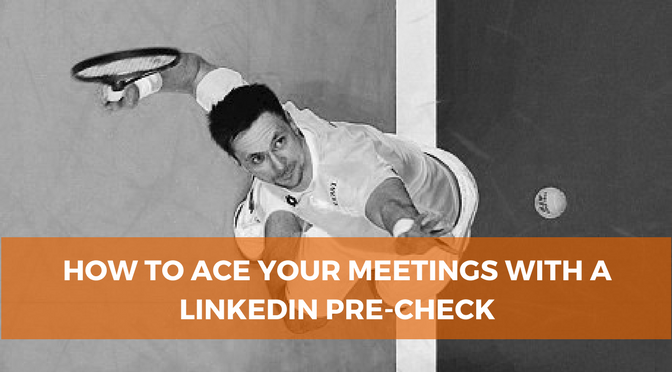How to Ace Your Meetings with a LinkedIn Pre-check
These days most professionals take at least a cursory look at a LinkedIn profile before meeting with someone they don’t yet know. This is especially true of business development people preparing to meet with a potential client for the first time. If it’s not always a part of your meeting preparations, it should be.
Why?
For one thing, it helps to know as much as possible about the person sitting across the table or computer screen from you.
Here’s an example of someone who neglected to refer to LinkedIn and is now kicking themselves in the butt. That someone is me.
Recently I was asked by one of my partners to sit in on a routine conversation with a prospective new client of his. Since my contribution to these calls is historically pretty low and since I was distracted with other priorities, I waited until I was on the call before I looked at the prospect's profile.
Bad move.
Was I ever surprised to find that this person was not in the role I assumed he was in. He was, in fact, the guy in charge. The uber budget owner. THE decision maker. The potential business we could eventually get from this person was at least 10X what I thought it was.
To make matters worse, my partner had not correctly vetted the prospect either. We would have - and should have - prepared much differently for this call.
But consulting the LinkedIn profile is not just a way to make sure you have your head in the right spot. It also provides you with information that can be used to help you establish rapport quickly. And rapport is generally a good thing when you’re trying to build a business relationship.
12 things you might find on a LinkedIn profile
I find there are two levels of information on a LinkedIn profile. The first is obvious and can be detected in a glance. The second level requires a little analysis.
LinkedIn profile Level 1 – the Facts
Current position and responsibilities
Previous jobs and responsibilities
Education - schools and major area(s) of study
Causes they support
Where they live
Certifications and licenses they hold
Major projects and cases they are working now – or have worked on in the past
Articles they have published
Presentations they’ve given
Awards and other recognition they’ve received
Skills and areas of expertise
LinkedIn Profile Level 2 – the Story
To get deeper into the information the profile holds, it can be useful to ask yourself some questions.
What does job history, volunteer status and areas of interest tell me about what’s important to this person?
What are their priorities?
Have they followed a systematic approach to get to where they are now or have they tried a lot of different things? And what does that tell me?
How many years of experience do they have in doing what they’re doing now?
What do we have in common?
Each of these bits of information can help you frame a conversation that leaves your prospective new client feeling good, open to your ideas and wanting to move to the next step.
And that is a very good meeting.
Check your calendar. Find your next meeting with someone you don't yet know. Go check them out on LinkedIn. Don't miss a golden opportunity by being unprepared.

